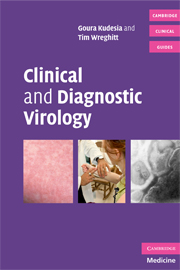Book contents
- Frontmatter
- Contents
- List of plates
- Preface
- Acknowledgements
- SECTION 1 INDIVIDUAL VIRUSES
- Introduction to virology
- 1 Adenoviruses
- 2 Arboviruses and haemorrhagic fever viruses
- 3 Cytomegalovirus (CMV)
- 4 Epstein–Barr virus (EBV)
- 5 Enteroviruses
- 6 Hepatitis A virus (HAV)
- 7 Hepatitis B and D viruses (HBV and HDV)
- 8 Hepatitis C virus (HCV)
- 9 Hepatitis E virus (HEV)
- 10 Herpes simplex virus (HSV)
- 11 Human immunodeficiency virus (HIV) and acquired immunodeficiency syndrome (AIDS)
- 12 Human herpes viruses types 6, 7 and 8 (HHV 6, 7 and 8)
- 13 Human T-cell leukaemia virus (HTLV)
- 14 Influenza viruses
- 15 Measles virus
- 16 Mumps virus
- 17 Noroviruses
- 18 Parainfluenza viruses
- 19 Papilloma and polyoma viruses
- 20 Parvovirus B19
- 21 Pox viruses
- 22 Rabies virus
- 23 Respiratory syncytial virus (RSV)
- 24 Rhinoviruses
- 25 Rotavirus
- 26 Rubella virus
- 27 SARS CoV and other coronaviruses
- 28 Varicella-zoster virus (VZV)
- SECTION 2 OTHER RELATED AGENTS
- SECTION 3 CLINICAL SYNDROMES
- SECTION 4 DIAGNOSTIC TECHNIQUES
- SECTION 5 PATIENT MANAGEMENT
- Index
- Plate section
27 - SARS CoV and other coronaviruses
Published online by Cambridge University Press: 07 December 2009
- Frontmatter
- Contents
- List of plates
- Preface
- Acknowledgements
- SECTION 1 INDIVIDUAL VIRUSES
- Introduction to virology
- 1 Adenoviruses
- 2 Arboviruses and haemorrhagic fever viruses
- 3 Cytomegalovirus (CMV)
- 4 Epstein–Barr virus (EBV)
- 5 Enteroviruses
- 6 Hepatitis A virus (HAV)
- 7 Hepatitis B and D viruses (HBV and HDV)
- 8 Hepatitis C virus (HCV)
- 9 Hepatitis E virus (HEV)
- 10 Herpes simplex virus (HSV)
- 11 Human immunodeficiency virus (HIV) and acquired immunodeficiency syndrome (AIDS)
- 12 Human herpes viruses types 6, 7 and 8 (HHV 6, 7 and 8)
- 13 Human T-cell leukaemia virus (HTLV)
- 14 Influenza viruses
- 15 Measles virus
- 16 Mumps virus
- 17 Noroviruses
- 18 Parainfluenza viruses
- 19 Papilloma and polyoma viruses
- 20 Parvovirus B19
- 21 Pox viruses
- 22 Rabies virus
- 23 Respiratory syncytial virus (RSV)
- 24 Rhinoviruses
- 25 Rotavirus
- 26 Rubella virus
- 27 SARS CoV and other coronaviruses
- 28 Varicella-zoster virus (VZV)
- SECTION 2 OTHER RELATED AGENTS
- SECTION 3 CLINICAL SYNDROMES
- SECTION 4 DIAGNOSTIC TECHNIQUES
- SECTION 5 PATIENT MANAGEMENT
- Index
- Plate section
Summary
The viruses
Coronaviruses (CoV), including SARS CoV, are single-stranded RNA viruses and belong to the family Coronaviridae.
Epidemiology
Route of spread
Coronaviruses are spread by the respiratory route.
Severe acute respiratory syndrome (SARS) is caused by SARS coronavirus (SARS CoV), which is spread by the respiratory route and through the ingestion of aerosolized faeces via contamination of the hands and environment. Close contact with a symptomatic person poses the highest risk of infection. In the 2003 outbreak, most cases occurred in hospital workers or family members in contact with cases.
Prevalence
Coronaviruses have a worldwide distribution and almost all adults in the UK have been infected by at least one type of coronavirus. Infection usually occurs in winter or spring and is associated with upper respiratory tract infection (a ‘cold’). The severity of illness is similar to that of rhinovirus infection, but less severe than infection with respiratory syncitial virus or influenza viruses. Symptoms are usually more severe in elderly persons. Reinfection is common.
SARS CoV caused a worldwide outbreak between March and July 2003, and there was a smaller outbreak, probably associated with laboratory-released SARS CoV, in 2004. There were over 8000 cases reported from 32 countries. There have been no more cases since then. The outbreak originated in Guandong Province in China and is thought to have been transmitted from civet cats (a variety of wild cat) to humans with subsequent human-to-human spread.
- Type
- Chapter
- Information
- Clinical and Diagnostic Virology , pp. 113 - 115Publisher: Cambridge University PressPrint publication year: 2009



